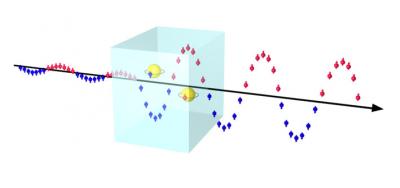Nov 17 2012
A fundamental cornerstone for spintronics that has been missing up until now has been constructed by a team of physicists at Linköping University in Sweden. It's the world's first spin amplifier that can be used at room temperature.
 A schematic picture of the defect-engineered spin amplifier demonstrated in this work. The wave pattern symbolizes the time variation of the spin signal, namely the difference between the numbers of spin-up and spin-down electrons.
A schematic picture of the defect-engineered spin amplifier demonstrated in this work. The wave pattern symbolizes the time variation of the spin signal, namely the difference between the numbers of spin-up and spin-down electrons.
Great hopes have been placed on spintronics as the next big paradigm shift in the field of electronics. Spintronics combines microelectronics, which is built on the charge of electrons, with the magnetism that originates in the electrons' spin. This lays the foundation for entirely new applications that fire the imagination. The word "spin" aims at describing how electrons spin around, much like how the Earth spins on its own axis.
But turning theory into practice requires amplifying these very weak signals. Instead of transistors, rectifiers, and so on, the building blocks of spintronics will be formed by things like spin filters, spin amplifiers, and spin detectors. Through regulating and controlling electron spin, it will be possible to store data more densely and process it many times faster – and with greater energy efficiency – than today's technology.
In 2009, an LiU group from the Department of Functional Electronic Material, led by Professor Weimin Chen, presented a new type of spin filter that works at room temperature. The filter lets through electrons that have the desired spin direction, screening out the others. This function is crucial for constructing new types of components such as spin diodes and spin lasers.
Now the same group, in collaboration with colleagues from Germany and the United States, has published an article in the highly-ranked journal Advanced Materials, where they present an effective spin amplifier based on a non-magnetic semiconductor. The amplification occurs through deliberate defects in the form of extra gallium atoms introduced into an alloy of gallium, indium, nitrogen and arsenic.
A component of this kind can be set anywhere along a path of spin transport to amplify signals that have weakened along the way. By combining this with a spin detector, it may be possible to read even extremely weak spin signals.
"It's an advance that blazes a trail for a solution to the problem of controlling and detecting electron spin at room temperature, which is a prerequisite for the breakthrough of spintronics," says Weimin Chen.